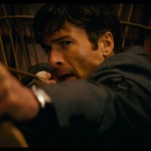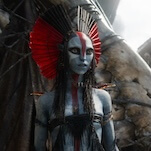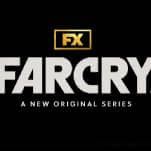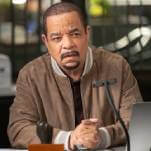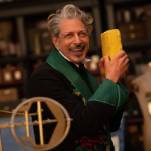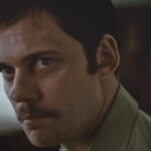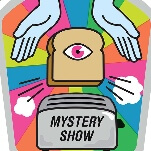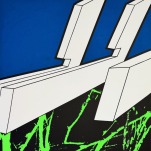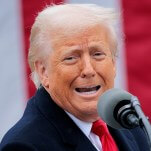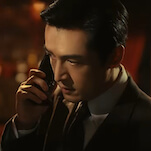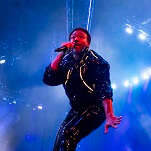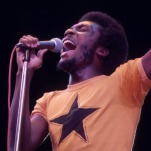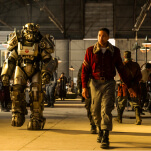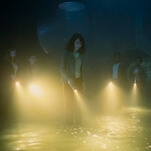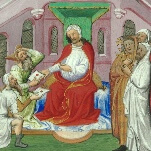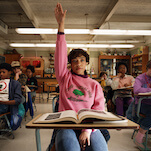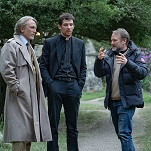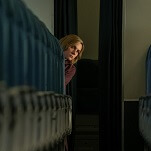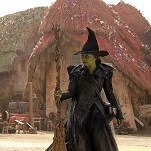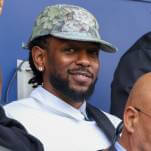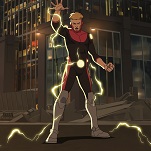With a new Star Wars movie set to come out seemingly every year for the rest of time, it may seem difficult to remember a time when fans had to fill in the gaps themselves. Before the release of George Lucas’ prequel trilogy—and after, as a form of denial—the Star Wars Expanded Universe did what wearing out tapes of the originals couldn’t by not only completing Han, Leia, and Luke’s stories, but also giving detailed histories to characters seen only briefly in the original trilogy. And when that wasn’t enough, the EU invented stories, locations and characters—even entire races—out of whole cloth.
Disney officially declared existing EU stories non-canon when it bought Lucasfilm in 2012, saying that, “While Lucasfilm always strived to keep the stories created for the EU consistent with our film and television content as well as internally consistent, Lucas always made it clear that he was not beholden to the EU.” (Lucas was never especially beholden to himself either, as any nerd in a “Han Shot First” shirt can tell you.) Since then, elements of the EU, like the Black Sun crime syndicate, have been restored to the canon by appearing in official Disney-sanctioned Star Wars media. But it’s a big galaxy, and there are plenty of compelling characters and stories out there still languishing in non-canonic purgatory. So amid the excitement of a bright, Star Wars-filled future, here’s what we’re sad to leave behind.
1. Mara Jade
The Expanded Universe produced thousands of characters in its lifespan—smugglers, Sith, warlords, freedom fighters—but none cast as long a shadow as Mara Jade. Introduced in Timothy Zahn’s 1991 Heir To The Empire, Mara was a capable smuggler and fighter driven by one urge: a blinding desire to kill Luke Skywalker. Before Return Of The Jedi she was the Emperor’s Hand, Palpatine’s prime spy and assassin, driven only to serve his will and eliminate his enemies, and now following his last wish to kill the son of his murderer. Her journey to free herself from the Emperor’s will and choose her own destiny becomes the vital arc of Zahn’s trilogy, and the character was so beloved by fans and authors she continued on to become the EU’s most widely used original character, and went from being Skywalker’s potential killer to wife and mother of his son. She even received an exclusive honor in her own Lucasfilm official model, Shannon McRandle, when fans overwhelmingly voted Jade to join the Star Wars Customizable Card Game. Supremely competent, frequently conflicted, and possessed of a droll sense of humor, Jade is easily the most well-rounded character the EU ever produced, and the one whose removal from canon produced the greatest outcry. [Les Chappell]
2. Grand Admiral Thrawn
When Timothy Zahn laid the foundations for the Expanded Universe in 1991’s Heir To The Empire, he gifted his just-invented New Republic with the worthiest foe it would ever face in the form of the dreaded Imperial Grand Admiral Thrawn. In hindsight, the cunning Chiss—think “a black-haired Smurf, but with glowing red eyes”—was probably a little too perfect. He’s essentially Sherlock Holmes as an evil alien general, out-foxing his enemies with psychology, analysis, and the galaxy’s deadliest art history degree. But for fans who’d just spent three movies watching Imperial high command shoot itself in the foot by endlessly indulging Sith-ily malicious incompetence, Thrawn’s approach to galactic domination was a breath of fresh air. No big, dumb superweapons, no gloating speeches, no ruling through fear—if Thrawn wanted to beat you, he’d do it through planning, cunning, and sound HR policies (like not magically choking subordinates every time they made an honest mistake). His thoughtful, intelligent type of malice will be missed. [William Hughes]
3. Kyp Durron
Kyp Durron’s story is one of the Expanded Universe’s most poignant long-term arcs. He starts as a very talented but troubled apprentice at Luke’s new Jedi academy in Kevin J. Anderson’s Jedi Academy trilogy. Then the ghost of an ancient Sith Lord turns the teenager so far to the dark side that he uses a weapon capable of destroying entire solar systems—the aptly named Sun Crusher—to murder millions before Han manages to turn him back to the light. Often in Star Wars, redemption only occurs in the moments before death, but in Kyp’s case, the journey is long, hard, and rewarding. It takes dozens of books written over the course of several years for the character to fully recover from his brush with the dark side. It’s a mythic journey lived at the pace of everyday life, a kind of storytelling that was unique to the Expanded Universe. These were truly never-ending stories, filled with dozens of characters whose journeys were constantly changing, evolving, and growing. They felt real, because they had no pre-determined point at which they had to end. [Gus Spelman]
4. Wraith Squadron
The benefit of the EU was that it was able to spend time in every corner of the Star Wars galaxy, and tell a lot of stories that you wouldn’t expect to see. In Aaron Allston’s Wraith Squadron trilogy, Wedge Antilles proposed the creation of a new kind of fighter squadron: one made up of individuals who were commandos first and pilots second, and who could develop new and unorthodox problem-solving tactics. Further complicating things, Antilles also proposed his team be filled with washouts and screwups, pilots who’d be gung-ho for a second chance. This created The Dirty Dozen of the New Republic: A demolitions expert-turned-pilot concealing anxiety attacks, a former child star riddled with guilt over his roles in Imperial propaganda holofilms, a Gamorrean whose intellect was genetically modified to genius levels, an Imperial Intelligence spy who grew to wish her cover was reality. Allston also managed to expertly balance these dark themes with humor, with a running joke about an Ewok pilot who amuses and frustrates the squadron at various points. Losing that energy is a blow, although the upcoming Rogue One is in a good position to remind you that you don’t need a lightsaber to be a hero. [Les Chappell]
5. The Yuuzhan Vong
Weird species with even weirder names were common in the Expanded Universe, but the Yuuzhan Vong were perhaps the most memorable. One of the only species to appear from an outside galaxy, the Yuuzhan Vong hated machines, loved pain, and traveled in living spaceships on a ruthless, religious crusade to conquer and enslave all other species and planets. They killed Chewbacca, looked like Darth Maul on meth, and had sticks made out of live wooden snakes that could stop a lightsaber blade. More importantly though, their society, psychology, and bizarre living-organism-based technology are depicted in such detail that the Yuuzhan Vong are one of the few instances in the EU where the “otherness” of an alien species doesn’t feel like a lazy reflection of real-world racial stereotypes. Instead, they were an endlessly fascinating force of evil precisely because our heroes could never come to any easy understanding of them, a smart choice for the primary antagonists of the EU’s longest series, New Jedi Order. [Gus Spelman]
6. The Noghri
The Noghri, essentially an entire race of primitive ninja assassins with a strict, honor-based matriarchal society, definitely rank among the Expanded Universe’s most badass creations. Whether they were fighting Wookiees in hand-to-hand combat or slipping a dagger into someone’s spine, the descriptions of their stealth and fighting skills were always exciting. But the coolest thing about them is probably the poignant history Timothy Zahn created for them in his Heir To The Empire trilogy: The story goes that Darth Vader himself tricked the honorable species into pledging their eternal loyalty to him after secretly poisoning their planet. They transferred their allegiance to the Empire after his death, and remained loyal to the Empire until encountering Luke. Their senses are so acute that they can smell his relation to Vader, prompting a complete 180 from Imperial assassins to full-time Skywalker/Solo family bodyguards. [Gus Spelman]
7. Kyle Katarn and Dash Rendar
Kyle Katarn and Dash Rendar are sort of the Dermot Mulroney and Dylan McDermott of the Star Wars Expanded Universe. Even the most intense Star Wars fanatic may have a hard time picking them out of a lineup: Both scruffy mercenaries who came around in the mid-’90s and would became allies to the Rebel Alliance, Rendar had the cooler name, but Katarn had an edge in that he was Force sensitive. Katarn was created for LucasArts’ answer to Doom and Dark Forces, and Rendar was the hero of the Star Wars multimedia event Shadows Of The Empire, which included the popular Nintendo 64 title. If Dash Rendar was created to be a Han Solo-by-proxy (Shadows takes place while the Corellian is imprisoned in carbonite), Katarn was LucasArts’ attempt at creating a character that combined the swagger of Solo with the Jedi ethos of Luke Skywalker. Per orders from Disney, Dark Forces and Shadows Of The Empire are no longer considered canon; however, while the character of Dash Rendar may not be canon, his ship Outrider is, as it appears briefly in the 1997 Star Wars: Episode IV—A New Hope Special Edition. [Mike Vanderbilt]
8. Starkiller
Galen Marek, the protagonist of the Force Unleashed video game, was a Force-adept little boy who was kidnapped by Darth Vader at some point after the prequels. Vader raised him and trained him in secret, hoping Marek could ultimately help him kill the Emperor. When this plan didn’t work out, though, Vader sent Marek, now code-named Starkiller, to find and bring together the most outspoken opponents of the Empire, convince them to work together, and then distract the Emperor with this insurgency so Vader could have another shot at killing him. However, Marek’s inherent goodness took over and he decided to help the rebels instead, eventually sacrificing his life so they could escape an Imperial trap. They went on to form the Rebel Alliance in his honor, but the fun twist is that all this spun out of Vader’s initial scheme. Was he really being evil, or did he know he was laying the groundwork for the Empire’s fall? We’ll never know, because Force Unleashed II didn’t go into it, and now Starkiller’s story is no longer canon. [Sam Barsanti]
9. HK-47
The answer to the tragically unasked question, “What if C-3PO possessed both the desire and the skills to murder every sentient being he met?,” droid assassin HK-47 stems from an even longer time ago in that galaxy far, far away. First appearing in BioWare’s role-playing game Knights Of The Old Republic, the sesquipedalian murder-bot serves as a great reminder of how the Expanded Universe allowed Star Wars to toy with tones outside its “epic adventure” default. Every time HK engages his vocabulator to expound on the joys of dispensing death, Star Wars shifts into the blackest of dark comedies, a Coen brothers-esque morality tale of inept killers, unlucky assassins, and one sardonic robot standing at the center of the mayhem. (It doesn’t hurt that, as voiced by Kristoffer Tabori, HK is honestly hilarious, a nice counterpoint to the idea that “droid comedy” has to be all “Roger, Roger”s and slapstick astromechs.) [William Hughes]
10. Han and Chewie’s solo adventures
Brian Daley’s three “Han Solo adventures” novels, all published in a back-to-back rush in 1979 and 1980, were possibly the first official Star Wars tie-ins to be declared non-canon. And it’s a particular shame, since there’s nothing in them that changes the larger Star Wars world (unlike, say, Alan Dean Foster’s 1978 Luke and Leia adventure novel Splinter Of The Mind’s Eye), but there’s plenty of detail that makes that world more interesting. Daley’s books take place on a wide stage, packing George Lucas’ galaxy with colorful species and fleshed-out non-human characters. Some of the better ones include Skynx, a Ruurian—essentially a large, highly intelligent caterpillar, complete with a three-stage metamorphic lifestyle—and Spray, whose people (the Tynnan) are more or less buck-toothed otter people with highly advanced political consciences. Daley’s novels fill in Han Solo’s working partnership with Chewbacca as they bounce from planet to planet, picking up jobs and struggling to make enough money to keep the Millennium Falcon repaired and stay ahead of the authorities. They suggest a blue-collar, working-class universe, with plenty of people just trying to make a daily living in a chaotic, competitive galaxy. Essentially, these books are Firefly more than 20 years before Firefly, with Han, Chewie, and their latest crop of allies going on small planet-to-planet adventures that feel grubbier and more real than the film series’ huge battles. They’re a solid foundation for Han Solo’s character, and it’s a shame they weren’t incorporated into the larger story. [Tasha Robinson]
11. The Cantina werewolves
When the Star Wars Special Editions were released in 1997, fans thought, “Oh, some of this stuff is kind of cool,” not knowing that the original theatrical cuts of the films would—as of now, anyway—never see an official re-release. Two victims of this revisionist history are Lak Sivrak and Arleil Schous, the werewolves seen patronizing the Mos Eisley cantina in Star Wars: Episode IV—A New Hope. While inconsequential to the plot of A New Hope, both characters were developed further in the Star Wars Expanded Universe, simply because every background character featured in Star Wars was developed further in the EU. During shooting, however, they were known simply as “Wolfman” and “Hyena-Man,” their masks taken off the rack from makeup artist Rick Baker’s studio. But the low-budget, Famous Monsters-esque masks and humanoid monsters were part of what made the Cantina scene so iconic, and contributed to the filthy, lived-in universe free of matching futuristic silver jumpsuits that George Lucas was striving to create. The sight of aliens that felt like regular folk simply hanging out at a bar—a sight which led to countless homages and parodies—were eventually, regrettably replaced with CGI aliens and Muppets that sanitized the wretched hive of scum and villainy that was Star Wars in 1977. [Mike Vanderbilt]
12. The 20th Century Fox fanfare
As the first episode of the Star Wars franchise to bring Luke Skywalker, Han Solo, and Princess Leia back to the big screen since 1983’s Return Of The Jedi, the mere idea of Star Wars: Episode VII—The Force Awakens was enough for some fans to declare it the best Star Wars film in 32 years before so much as the first official promo photo had been released. Unfortunately, as the first installment of the saga to emerge since Lucasfilm became part of the Disney empire, The Force Awakens will also find moviegoers experiencing another inaugural event: Never before has a live-action Star Wars film kicked off without the 20th Century Fox fanfare. As such, don’t be surprised if more than a few fans have the appropriate MP3 cocked and ready as soon as the lights go down. [Will Harris]





